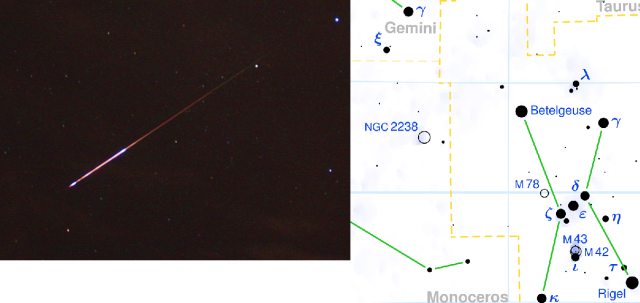
Have you ever heard the superstition that you should wish upon a falling star? If you do that this week, you might just be wishing upon a piece of Halley’s Comet burning up in our atmosphere! Falling or shooting stars have nothing to do with stars. Instead, what scientists call meteors are flashes of light caused when a tiny piece of a comet enters our atmosphere and burns up. Imagine your car driving into a swarm of insects and watching them go splat on your windshield. That’s not a bad analogy for the earth running into a swarm of meteoroids, debris liberated by a comet as it orbits the sun. When earth passes through the orbit of a particular comet (which, for any particular comet, will occur at the same time each year), many of these meteoroids burn up, creating a meteor shower. A meteor shower is named not after the comet whose particles create it, but rather where in the sky the meteors seem to radiate from, or the radiant. The brightest constellation in the region usually lends its name.
We are currently in the midst of the Orionid meteor shower, whose radiant lies between Orion’s bright shoulder star Betelgeuse and the bottom stars of Gemini (see above). Depending on how the meteoroid field is configured (for example, the size and number of particles, and the width of the meteoroid field), a meteor shower can last for a few days up to a few weeks, but there is usually a narrow window where we hit the densest part of the stream and hence see the largest number of meteors per hour. This year the Orionids are expected to peak in the predawn hours of Saturday, October 21.
The Orionids are certainly not the best meteor shower of the year (at peak you might only see 20 per hour, and each meteor is not particularly bright), but it has a unique romantic charm due to the identity of its parent comet, Comet P/Halley, or as most people know it, Halley’s Comet. While the comet itself won’t be in our neighborhood again until 2061, each year we actually get two meteor showers from the material it left behind on previous journeys around the sun – the Orionids in mid-October and the Eta Aquarids in early May.
If you find yourself up before dawn this week, why not take a peek out your window in the direction of Orion, and see if you can make a wish on an Orionid – mine will certainly be to be alive when Halley’s Comet returns in 2061 so I can become a member of the Halley’s Comet two-timer club!
